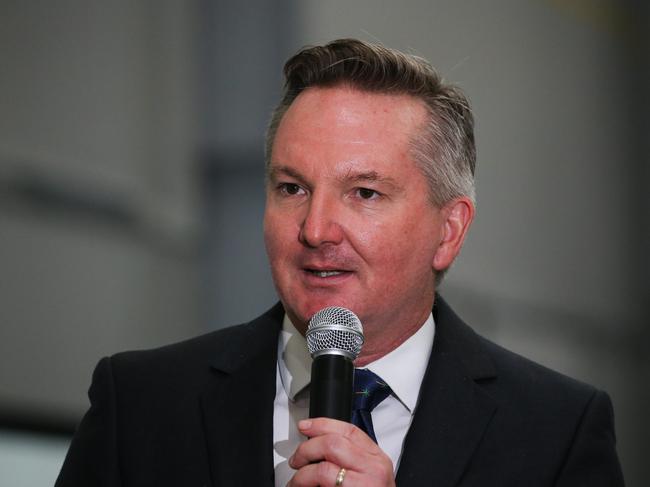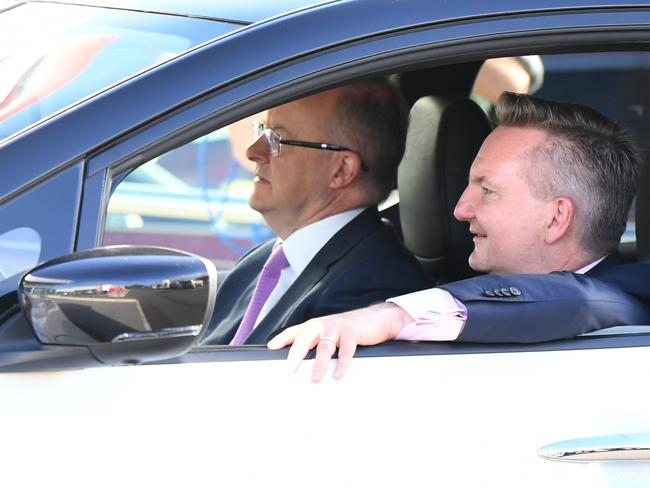US slows vehicle emissions rules as Australia faces calls to follow suit
Climate Change and Energy Minister Chris Bowen will “consider sensible suggestions” about relaxing its emissions targets after the US pulled back on its EV plan.
World
Don't miss out on the headlines from World. Followed categories will be added to My News.
The Australian government is coming under increasing pressure to adjust its controversial New Vehicle Efficiency Standard (NVES) after the US signalled a softening of its emissions targets overnight.
Industry groups have called on the government to follow the US lead and reshape its NVES policy, which has been described by some experts as the toughest in the world.
Climate Change and Energy Minister Chris Bowen on Thursday said the changes made in the US were “of interest to us” and would be taken into consideration as he and Transport Minister Catherine King finalised the government’s policy.
“As Catherine King and I have said all along, we are happy to consider sensible suggestions that ensure the policy does what it’s intended to, and that is to give Australian’s more choice of vehicles that cost less to drive.
“That’s why we released three options, for industry and stakeholders to work with us and consult on.”

Head of the Federal Chamber of Automotive Industries Tony Weber said the government should follow the US lead.
“The Australian Government has consistently said that it is using the US scheme as a guide. Rushing to introduce a scheme, in just nine months time, without learning from the US experience is a recipe for disaster in Australia,” said Mr Weber.
Motor Traders Association chief executive Matt Hobbs said “the Australian trajectory is the hardest in the world at the moment”.
“They need to look closely at what the US is doing, because that’s the reality of what the industry is doing globally,” he said.
The Biden administration has heeded warnings from the car industry and will ramp up targets more slowly, meaning fewer electric vehicles will need to be sold before 2030.
In order to hit the targets for the end of the decade, it is now expected that between 31 per cent and 44 per cent of new light vehicle sales will be of electric cars, rather than 60 per cent under the original plan.
EPA boss Michael Regan said carbon emissions would still fall by the same amount over 30 years, but that the revised policy would be “stronger, more durable”.

The Alliance for Automotive Innovation – representing dozens of car companies which manufacture almost all new vehicles sold in the US – welcomed the change.
“Moderating the pace of EV adoption in 2027, 2028, 2029 and 2030 was the right call,” chief executive John Bozzella said in a statement.
“These adjusted EV targets – still a stretch goal – should give the market and supply chains a chance to catch up.”
Australia is one of the few countries in the world that does not impose mandatory vehicle pollution caps, prompting Climate Change and Energy Minister Chris Bowen to last month unveil plans for an efficiency standard to align with American rules by 2028.
But the Federal Chamber of Automotive Industries warned his approach was overly aggressive and would drive up the cost of larger petrol cars and vehicles by thousands of dollars if manufacturers could not offset them with increased electric car sales.
Opposition Leader Peter Dutton has called the plan a tax on new family cars and utes.
In the US, former president Donald Trump has similarly sought to attack President Joe Biden over his electric vehicle policies amid a bruising election rematch.
This has put Mr Biden under pressure to implement the emissions rule before Americans go to the polls in November, while also shoring up support among unionised auto workers who fear the EV transition is putting their jobs at risk.
- additional reporting Richard Blackburn and Dominic Tripolone





